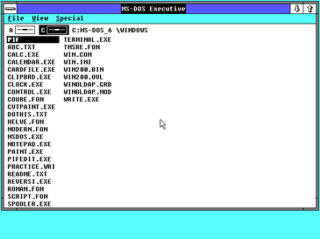Related Research Articles

William Thomas "Will" Riker is a fictional character in the Star Trek universe appearing primarily as a main character in Star Trek: The Next Generation, portrayed by Jonathan Frakes. Throughout the series and its accompanying films, he is the Enterprise's first officer, and briefly captain, until he accepts command of the USS Titan at the end of Star Trek: Nemesis. He is the husband of Deanna Troi.

Digital Research, Inc. was a privately held American software company created by Gary Kildall to market and develop his CP/M operating system and related 8-bit, 16-bit and 32-bit systems like MP/M, Concurrent DOS, FlexOS, Multiuser DOS, DOS Plus, DR DOS and GEM. It was the first large software company in the microcomputer world. Digital Research was originally based in Pacific Grove, California, later in Monterey, California.

Coherent is a clone of the Unix operating system for IBM PC compatibles and other microcomputers, developed and sold by the now-defunct Mark Williams Company (MWC). Historically, the operating system was a proprietary product, but it became open source in 2015, released under the BSD-3-Clause license.

Columbia Data Products, Inc. (CDP) is a company which produced the first legally reverse-engineered IBM PC clones. It faltered in that market after only a few years, and later reinvented itself as a software development company.

The IBM 3790 Communications System was one of the first distributed computing platforms. The 3790 was developed by IBM's Data Processing Division (DPD) and announced in 1974. It preceded the IBM 8100, announced in 1979.
OfficeVision was an IBM proprietary office support application.
Comprehensive Electronic Office (CEO) was a suite of office automation software from Data General introduced in 1981. It included word processing, e-mail, spreadsheets, business graphics and desktop accessories. The software was developed mostly in PL/I on and for the AOS and AOS/VS operating systems.

Nixdorf Computer AG was a West German computer company founded by Heinz Nixdorf in 1952. Headquartered in Paderborn, Germany, it became the fourth largest computer company in Europe, and a worldwide specialist in banking and point-of-sale systems.

Applied Data Research (ADR) was a large software vendor from the 1960s until the mid-1980s. ADR is often described as "the first independent software vendor".
IBM Distributed Office Support System, or DISOSS is a centralized document distribution and filing application for IBM's mainframe computers running the MVS and VSE operating systems. DISOSS runs under both the CICS transaction processing system and the IMS/DS transaction processing system, and later versions use the SNADS architecture of peer to peer communication for distributed services.
DUCS was a teleprocessing monitor from CFS Inc. It was one of two early local teleprocessing packages for IBM's DOS/VSE environment. DUCS provided an interface and access method for programmers to 'talk' to monitors. Such access methods later became known as APIs.
DOCS was a software package for IBM mainframes by CFS Inc., enabling access to the system console using 3270-compatible terminals.
Edos is a discontinued operating system based upon IBM's original mainframe DOS. The name stood for extended disk operating system. It was later purchased by the West German computer company Nixdorf, who renamed it to NIDOS.

GRASP was a systems software package that provided spooling facilities for the IBM/370 running DOS/VS or DOS/VSE environment, and IBM/360 running DOS or retrofitted with modified DOS.

Windows 2.0 is a major release of Microsoft Windows, a family of graphical operating systems for personal computers developed by Microsoft. It was released to manufacturing on December 9, 1987, as a successor to Windows 1.0.

Altos Computer Systems was founded in 1977 by David G. Jackson and Roger William Vass Sr. It focused on small multi-user computers, starting with multi-user derivatives of CP/M, and later including Unix and Xenix-based machines. In its 1982 initial public offering on NASDAQ, the company raised $59M. Thereafter the company's stock was traded under the symbol ALTO.
Computer Associates Panvalet is a revision control and source code management system originally developed by Pansophic Systems for mainframe computers such as the IBM System z and IBM System/370 running the z/OS and z/VSE operating systems.
The Digital Computer Association (DCA) was established in November 1952 in Santa Monica, California. It was disbanded in 1994.
Boole & Babbage Incorporated, founded as K & K Associates, was an American automation computer software company based in San Jose, California. It was the oldest systems management company in the world before being bought out in a stock swap by BMC Software, announced in late 1998 and completed in early 1999.
CP-6 is a discontinued computer operating system, developed by Honeywell, Inc. in 1976, which was a backward-compatible work-alike of the Xerox CP-V, fully rewritten for Honeywell Level/66 hardware. CP-6 was a command line oriented system. A terminal emulator allowed use of PCs as CP-6 terminals.
References
- ↑ "Mainframe System Management with MainView". BMC Software UK. Retrieved 2016-08-02.
- ↑ "MainView". Justia Trademarks. Retrieved 2016-08-02.
- ↑ Computerworld 8 Oct 1990. Vol. 24 (41 ed.). IDG Enterprise. 1990. p. 41. ISSN 0010-4841.
- ↑ "MainView goes parallel". Software Industry Report. Archived from the original on 2016-09-10. Retrieved 2016-08-02.
- ↑ Computerworld 29 Nov 1993. IDG Enterprise. 1993. p. 104. ISSN 0010-4841.
- ↑ "BMC discloses some plans for Boole & Babbage". Computergram International . Archived from the original on 2016-09-11. Retrieved 2016-08-02.
- ↑ "BMC Unveils MainView for Java Environments Enabling a Transaction Engine for Digital Business". Wireless News. Archived from the original on 2016-09-11. Retrieved 2016-08-02.
- ↑ TrekCore Staff (October 2013). "EXCLUSIVE: Inside Boole & Babbage's Trek 'Vision'". TrekCore. Retrieved 2016-08-02.
- ↑ "Commander Riker highlights Boole blitz. (actor Jonathan Frakes makes appearance with Boole & Babbage Inc. at CMG Conference) (firm's MainView for OS/2 application)". Software Magazine. Archived from the original on 2014-06-29. Retrieved 2016-08-02.